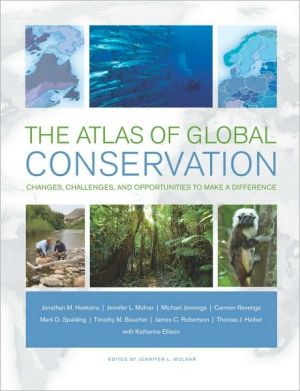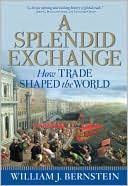The Atlas of Global Conservation: Changes, Challenges, and Opportunities to Make a Difference
Visually rich, up-to-date, and authoritative, The Atlas of Global Conservation is a premier resource for everyone concerned about the natural world. Drawing from the best data available, it is an unprecedented guide to the state of the planet and our most pressing resource and environmental issues. Top scientists at The Nature Conservancy, the leading conservation organization working around the world to protect ecologically important lands and water, have joined forces to create this...
Search in google:
"What a treasure! It's exciting to see so much real information about nature and its fate presented so beautifully and accessibly. The Atlas' fact-backed case for urgent action builds steadily to a compelling conclusion. And the writing is every bit as good as the excellent graphics and photographs."—James Gustave Speth, author of Red Sky at Morning: America and the Crisis of the Global Environment"Just as that first image of earth from space revealed the miraculous living planet we call home in a new light, this atlas rivets our attention both on its wonders and the opportunities to conserve it and provide a passport to a better future."—Thomas E. Lovejoy, The Heinz Center"An amazing book. The story of life on earth, told through one-of-a-kind maps, stunning photos, and engaging stories. For decades, scientists have dreamed of the day when we would have enough information about the world's biodiversity to prepare maps like these. A must-have resource, source of inspiration, and guide for action."—Walter V. Reid, David and Lucile Packard Foundation"Maps inspire conservation and partnerships everywhere we work. We should be grateful that one of the rising stars in conservation science, Jon Hoekstra, and his team, here give us superlative global data and maps of the world's riches and threats. An Atlas that focuses the mind on our investments where they can make the greatest difference."—Carter Roberts, World Wildlife Fund VOYA Focusing primarily on biomes and ecosystems, this valuable atlas promotes a deeper understanding of the challenges involved in preserving and maintaining these habitats and resources. Basically an analysis of the current state of the globe, the book highlights conservation challenges through chapters on habitats, species distributions, deforestation, global warming, coastal development, and pollution. While discussing such depressing issues as the world's alarming human population densities, overconsumption of resources, high levels of water stress, and the extinction of species, there are also details of positive efforts being made to mitigate damages and preserve our remaining resources. Many of the facts and statistics available here are not found in most atlases and are presented at a level any student can absorb. The eco-region maps in the appendixes are a fascinating look at the uniqueness of many places across the globe. The book is unique and well done. Reviewer: Kevin Beach
Acknowledgments xFOREWORD • A NEW VIEW OF OUR HOME xii Mark Tercek, The Nature ConservancyFOREWORD • CONSERVATION CONNECTIONS xiv Paul R. Ehrlich, Stanford University, Stanford University1. Introduction 1WHY ECOREGIONS? 6Taylor Ricketts, World Wildlife FundTerrestrial Ecoregions, Realms, and Biomes 8Freshwater Ecoregions and Basins 10Marine Ecoregions, Provinces, and Realms 12THE STORIES THAT MAPS TELL 14Jon Christensen, Stanford University2. Habitats 19Forests and Woodlands: Giving Trees 22Grasslands: Where the Buffalo Roamed 24Deserts and Aridlands: Hardy Life under Harsh Conditions 26Rivers and Wetlands: The Planet's Lifeblood 28Lakes: Fragile Pools of Life 30Caves and Karst: Troves of Subterranean Species 32HOPE IN HABITATS 34Steven J. McCormick, Gordon and Betty Moore FoundationCoasts and Shelves: The Sea's Sunlit Margins 36Coral Reefs: Crown Jewels of the Ocean 38Mangrove Forests: Bridging Land and Sea 40Seagrass Beds: Marine Meadows 42Salt Marshes: Living Filters along Our Coasts 44High Seas and Deep Oceans: Earth's Uncharted "Inner Space" 463. Species 49Plants: A Vital Variety 52Freshwater Fish: A Diverse Cast 54Amphibians: Fragile Markers of the Planet's Health 56Reptiles: Prehistoric Survivors 58MIGRATIONS 60Martin Wikelski, Max Planck Institute for Ornithology and Konstaz University, and David S. Wilcove, Princeton UniversityBirds: Everyday, Everywhere Wildlife 64Mammals: Shared Destiny with Our Closest Kin 66Endemic Species: In the Narrowest Niches 68Evolutionary Distinction: Branches on the Tree of Life 70PROMOTING LIVELIHOODS, SAVING NATURE 72Greg Mock, former editor, World Resources Report4. A World of Change 75Human Population: Outnumbering Nature 78Consuming Nature: Running Out of Planet? 80Climate Change: The Planetary Emergency 82ULTIMATE AGENTS OF GLOBAL CHANGE 84Joel E. Cohen, Rockefeller and Columbia UniversitiesHabitat Loss on Land: Going, Going,… 88Coastal Development: Reshaping the Seashore 90Bottom Trawling and Dredging: Scouring the Seafloor 92Landscape Fragmentation: Going to Pieces 94Thwarted Fish Runs: Up against a Wall 96GLOBAL CONTAMINATION OF THE BIOSPHERE 98John Peterson Myers, Environmental Health SciencesFreshwater Pollution: Clear but Hazardous 102Nitrogen Pollution: Too Much of a Good Thing 104Ruin of the Reefs: Fading Jewels, Lost Wealth 106Into the Wild: The Cost of Expanding Human Access 108POVERTY AND NATURE'S SERVICES 110M. Sanjayan, The Nature ConservancyForest Clearing: Uprooting Nature 112Water Stress: Overused and Undermanaged 114Overfishing: Emptying the Oceans 116Wildlife Trade: Sold into Extinction 118FUTURE OF FISHERIES 120Jackie Alder, United Nations Environment Programme, and Daniel Pauly, University of British ColumbiaFire: Healthy Doses of Destruction 122Dams and Reservoirs: Clogging Earth's Arteries 124Sediment Flow: Starving Some Habitats, Smothering Others 126Melting Ice and Rising Seas: Squeezing the Coasts 128Disappearing Glaciers: Ice Storage on a Slippery Slope 130NATURE CONSERVATION AND CLIMATE CHANGE 132Jonathan M. Hoekstra, The Nature ConservancyTerrestrial Invaders: Unwelcome Guests 134Freshwater Invaders: Good Intentions with Costly Consequences 136Marine Invaders: Stowaways Attacking Our Coasts 138Terrestrial Animals at Risk: More in Jeopardy Each Year 140Freshwater Animals at Risk: Are Their Futures Drying Up? 142Marine Animals at Risk: Sea Life Unraveling 1445. Taking Action 147Protected Areas on Land: Triumph for Nature 150Protecting Rivers, Lakes, and Wetlands: Thinking beyond Park Boundaries 152Marine Protected Areas: Oases for Fish and People 154Protecting Nature's Services: Dividends from the Wealth of Nature 156CONVERGENT CONSERVATION 158Scott A. Morrison, The Nature ConservancyInternational Cooperation: Saving the Whales—and More 160Greening the Marketplace: Certifiably Profitable 162Collaborative Solutions: Problem-Solving Partnerships 164CONSERVATION ON OUR WATCH 166Gretchen C. Daily, Marilyn Cornelius, and Charles J. Katz, Jr., Stanford University, and Brian Shillinglaw, New Forests, Inc.Rule of Law: Protecting the Commons 168Individual Action: Parting the Waters 170Restoring Nature: Mending the Web of Life 1726. Conclusion Our Future, Our Choices 175Appendix A: Ecoregions Index Maps 180Appendix B: Technical Notes and References 200Index 229About the authors 234
\ VOYA - Kevin Beach\ Focusing primarily on biomes and ecosystems, this valuable atlas promotes a deeper understanding of the challenges involved in preserving and maintaining these habitats and resources. Basically an analysis of the current state of the globe, the book highlights conservation challenges through chapters on habitats, species distributions, deforestation, global warming, coastal development, and pollution. While discussing such depressing issues as the world's alarming human population densities, overconsumption of resources, high levels of water stress, and the extinction of species, there are also details of positive efforts being made to mitigate damages and preserve our remaining resources. Many of the facts and statistics available here are not found in most atlases and are presented at a level any student can absorb. The eco-region maps in the appendixes are a fascinating look at the uniqueness of many places across the globe. The book is unique and well done. Reviewer: Kevin Beach\ \ \ \ \ School Library JournalGr 8 Up—Assembled from hundreds of authoritative sources, this valuable atlas will promote a deeper understanding of the immense variety of our world's ecosystems and the array of challenges to their continued stability. Following an introductory overview, brightly colored maps and accompanying essays are arranged in broad categories to highlight, in turn, major habitats; species distributions; ominous changes arising from a range of causes from coastal development to pollution; and effective, protective measures such as establishing nature preserves and regulation of commerce. National boundaries are present but almost invisible on the world maps presented on nearly every spread; instead, it's the natural boundaries of mangrove forests and marine reefs, the color-coded indications of species diversity, human population density, levels of water stress, and like information that stand out, conveying the truth that environmental issues belong to all of us. Gorgeous nature photos on nearly every spread further enhance the presentation. The authors of the substantial narratives eloquently promote the same view while keeping the facts and statistics at digestible levels and gathering the extensive technical notes at the end. Closing with a second set of maps that divide the world into "realms" and show the hundreds of land and water "ecoregions" in each, this work can't help but promote a broader worldview in students of ecology, nature, and conservation—John Peters, New York Public Library\ \








